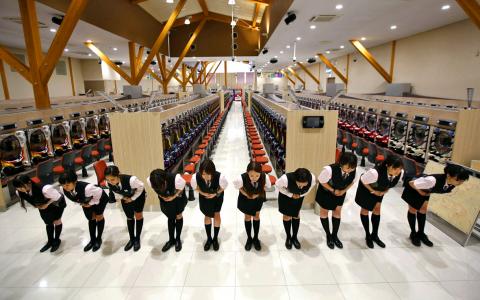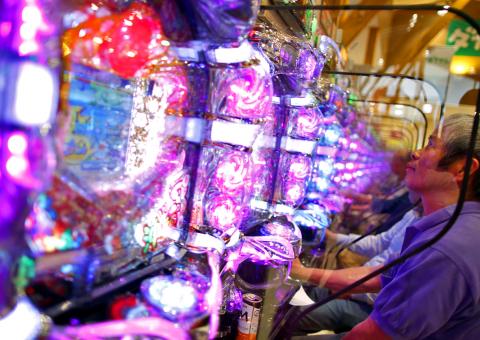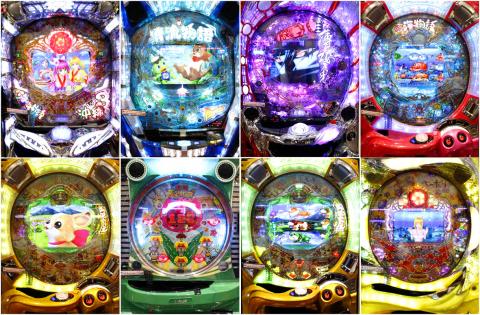Japan’s once-booming pachinko industry, grappling with a graying customer base and the threat of new competition from casinos, is adopting a softer touch and smoke-free zones to lure a new generation of players, particularly women.
Pachinko, a modified version of pinball, is a fading national obsession, with about 12,000 parlors nationwide and one in 13 people playing the game.
However, that figure is declining as the population shrinks and younger people prefer games on their mobile phones.

Photo: Reuters
To try and reverse the trend, some pachinko operators have built spacious, airy parlors designed to attract more women and younger players to a pastime tarred by its association in the public mind with older and idle men given to chain smoking.
Catering to different tastes to boost an industry that still sees about US$185 billion wagered annually, machines in pachinko parlors now feature anime characters, games and idols, ranging from all-girl group AKB48 to Resident Evil, a videogame blockbuster by Capcom Co that was made into a Hollywood film.
“We’re trying to change the image of pachinko as loud, smoke-ridden and male-dominated,” said Tomoko Murouchi, a spokeswoman for one of the largest operators, Dynam Japan Holdings.

Photo: Reuters
Dynam, which has 371 pachinko parlors around Japan, is building new game centers with higher ceilings, smoke-free zones and ventilators, with dividers between machines for privacy.
Rival Maruhan Corp, Japan’s largest pachinko chain by money wagered, has tried opening buffets at parlors and promoting a new kind of pachinko, but has recently shifted focus back to existing players, spokesman Kenjiro Shimoda said.
More than half of Dynam’s customers are older than 50, with just 9 percent younger than 30. However, the number of youthful players has almost doubled from 5 percent in 2006.

Photo: Reuters
About 200 people queued at the recent grand opening of a Dynam parlor in Fuefuki City, 100km west of Tokyo.
Although women make up just 27 percent of players at Dynam’s parlors, Marina Osada, a clerk, said she played pachinko three times a week, sometimes for the entire day when she was off work.
“I still remember the day I hit a jackpot and saw a very rare — the best — scene from the anime Basilisk. I was so happy,” said Osada, 21, who looks for machines that feature her favorite anime.
“Pachinko used to be just for men, but I like pachinko. I come alone, and just focus,” she said.
Pachinko revenues are falling as Japan’s population ages.
Gross revenue has shrunk to ¥19 trillion (US$185.75 billion) from ¥31 trillion over the past two decades, and the number of players halved between 2002 and 2012, research by investment bank Morgan Stanley shows.
Part of the problem has been a 15-year economic slump just ending. Spending on all kinds of leisure has dropped by almost a third over the past 20 years, but the number of players per machine has roughly halved since 2000 to stand at just over two in 2012, Morgan Stanley estimates.
Japan’s moves to legalize casino resorts could force pachinko out of the gray zone where it has thrived for decades. It faces no gaming taxes, since it is not treated as gambling, which is illegal, but is viewed instead as an amusement.
Pachinko began as a children’s toy in the 1920s, which gained popularity among adults after World War II.
Machines spew out winnings in the form of small metal balls. Most players opt to swap winnings for cash, with 87 percent of players at Dynam going this route.
Maruhan and Dynam have fared better than the rest of the industry, which is dominated by family-owned firms. Maruhan’s annual revenue after payouts was about ¥80 billion for the fiscal year that ended in March, up about 16 percent from 2012. For Dynam, revenue was flat over the same period.
However, even big operators face difficulties, one expert says.
“Every year, fewer and fewer people are playing pachinko,” said Tohru Okazaki, who has published five books on the industry. “Young people are simply not playing.”
Young people stopped because payouts are smaller and they find it harder to borrow money, said Naomi Suzuki, whose family runs a chain of parlors in the Fukushima Prefecture that was hit by the 2011 earthquake and the nuclear crisis that followed.
“Twenty years ago, pachinko parlors were full of young people, but now it’s mostly all middle-aged and old people that come and play,” Suzuki said. “Young people have no money.”

To many, Tatu City on the outskirts of Nairobi looks like a success. The first city entirely built by a private company to be operational in east Africa, with about 25,000 people living and working there, it accounts for about two-thirds of all foreign investment in Kenya. Its low-tax status has attracted more than 100 businesses including Heineken, coffee brand Dormans, and the biggest call-center and cold-chain transport firms in the region. However, to some local politicians, Tatu City has looked more like a target for extortion. A parade of governors have demanded land worth millions of dollars in exchange

An Indonesian animated movie is smashing regional box office records and could be set for wider success as it prepares to open beyond the Southeast Asian archipelago’s silver screens. Jumbo — a film based on the adventures of main character, Don, a large orphaned Indonesian boy facing bullying at school — last month became the highest-grossing Southeast Asian animated film, raking in more than US$8 million. Released at the end of March to coincide with the Eid holidays after the Islamic fasting month of Ramadan, the movie has hit 8 million ticket sales, the third-highest in Indonesian cinema history, Film

Taiwan Semiconductor Manufacturing Co’s (TSMC, 台積電) revenue jumped 48 percent last month, underscoring how electronics firms scrambled to acquire essential components before global tariffs took effect. The main chipmaker for Apple Inc and Nvidia Corp reported monthly sales of NT$349.6 billion (US$11.6 billion). That compares with the average analysts’ estimate for a 38 percent rise in second-quarter revenue. US President Donald Trump’s trade war is prompting economists to retool GDP forecasts worldwide, casting doubt over the outlook for everything from iPhone demand to computing and datacenter construction. However, TSMC — a barometer for global tech spending given its central role in the

Alchip Technologies Ltd (世芯), an application-specific integrated circuit (ASIC) designer specializing in server chips, expects revenue to decline this year due to sagging demand for 5-nanometer artificial intelligence (AI) chips from a North America-based major customer, a company executive said yesterday. That would be the first contraction in revenue for Alchip as it has been enjoying strong revenue growth over the past few years, benefiting from cloud-service providers’ moves to reduce dependence on Nvidia Corp’s expensive AI chips by building their own AI accelerator by outsourcing chip design. The 5-nanometer chip was supposed to be a new growth engine as the lifecycle